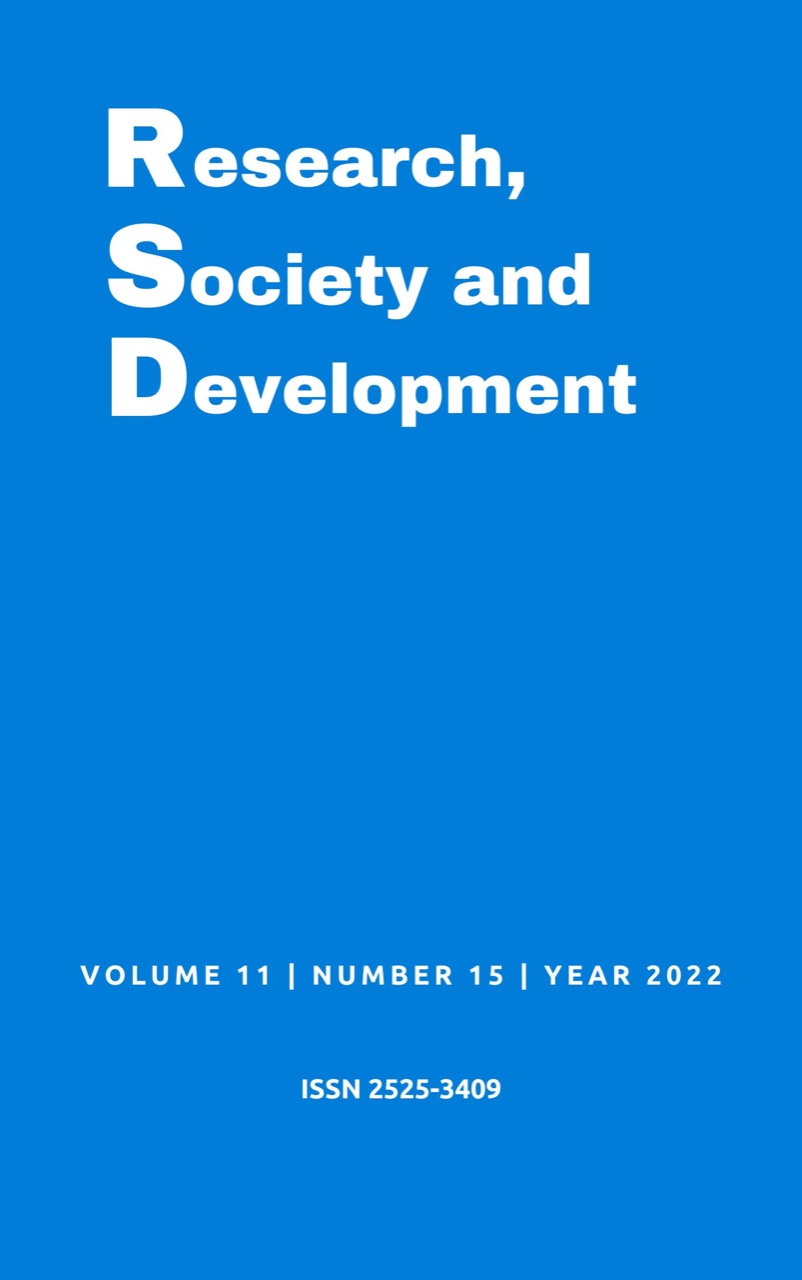Postnatal consultation: Reports of obstetric violence
DOI:
https://doi.org/10.33448/rsd-v11i15.37415Keywords:
Obstetric violence, Postnatal care, Complications of labor.Abstract
Objective: to describe how the nurse can identify, in the puerperal consultation, women who have suffered obstetric violence in the maternity ward. Methodology: this is an integrative literature review, in which the Virtual Health Library (VHL) was used as a database for the collection of articles, the studies of the last 05 years were analyzed, available in full and in the Portuguese language. Result: when analyzing the crossing between the descriptors “Obstetric violence” AND “Postnatal care” in the VHL, 14 results were obtained in total. After selecting Portuguese-language articles published in the last 5 years (n= 6 results). After reading the title (n=02 articles). After reading the abstract (n=01 article). When the descriptors “Obstetric violence” AND “Complications of labor” were confronted, 05 articles were shown as a result, of which 02 were in Portuguese and published in the last 5 years. In sequence, with reading of titles and abstracts (n= 02 articles); so the total of studies evaluated were 03 articles. Conclusion: Therefore, through the present study, it was observed that women still suffer OV during their passage through the maternity hospital, in their prepartum, delivery and postpartum processes. Such violence violates their rights as a human being and is practiced by birth care professionals, in places that should take and offer more protection to these women. Unfortunately, these women end up having a negative childbirth experience.
References
Amarijo, C. L., et al. (2021). Dispositivos de energia utilizados por enfermeiros para combater a violência doméstica contra a mulher. Texto & Contexto – Enfermagem. v. 30. https://doi.org/10.1590/1980-265X-TCE-2019-0389.
Andrade B. P., & Aggio C. M. (2014). Violência obstétrica: a dor que cala. Anais do III Simpósio Gênero e Políticas Públicas. 2177(1-7).
Bardin, L. (2011). Análise de conteúdo. (4a ed.), Edições.
Brasil. (1998). Presidência da República. Lei Nº 9.610, de 19 de fevereiro de 1998. http://www.planalto.gov.br/ccivil_03/leis/l9610.htm.
Camacho, K. G., et al. (2010). Vivenciando repercussões e transformações de uma gestação: perspectivas de gestantes. Cienc. Enferm. 16(2), 115-125. http://www.scielo.cl/scielo.php?script=sci_arttext&pid=S0717-95532010000200012&lng=pt&nrm=iso.
Carvalho, I. S., & Brito, R. S. (2017). Formas de violência obstétrica vivenciadas por puérperas que tiveram parto normal. Enferm. glob. V.16(47), 71-97. http://dx.doi.org/10.6018/eglobal.16.3.250481.
Cunha, A. L., et al. (2020). Produção de conhecimento sobre violência obstétrica: O lado invisível do parto. Revista Nursing, 23(260), 3529-3532. Revista
Marques, S. S., et al. (2017). Estratégias para identificação e enfrentamento de situação de violência por parceiro íntimo em mulheres gestantes. Revista Gaúcha de Enfermagem. 38(3). https://doi.org/10.1590/1983-1447.2017.03.67593.
Jardim, D. M. B., & Modena, C. M. (2018). A violência obstétrica no cotidiano assistencial e suas características. Rev. Latino-Am. Enfermagem. v. 26. 1-12.
Lansky, S., et al. (2019). Violência obstétrica: influência da Exposição Sentidos do Nascer na vivência das gestantes. Ciência & Saúde Coletiva. 24(8), 2811-2824. https://doi.org/10.1590/1413-81232018248.30102017.
Melo, J. S., et al. (2021). Relatos de puérperas sobre vivências de violência obstétrica: Um estudo qualitativo. Research, Society and Development, 10(8). e12310817081. http://dx.doi.org/10.33448/rsd-v10i8.17081
Moura, F. M. J., et al. (2007). A humanização e a assistência de enfermagem ao parto normal. Revista Brasileira de Enfermagem. 60(4). https://doi.org/10.1590/S0034-71672007000400018.
Muniz, B. M. V., & Barbosa, R. M. (2012). Problematizando o atendimento ao parto: cuidado ou violência. In Memorias. Memorias Convención Internacional de Salud Pública, Cuba Salud 2012.
Oliveira, L. L. F., et al. (2022). Caracterização da assistência obstétrica desenvolvida em hospitais de ensino de uma capital do nordeste Brasil. Revista Brasileira de Enfermagem. 75(01). https://doi.org/10.1590/0034-7167-2020-0896.
Organização Mundial da Saúde (OMS). (2014). Prevenção e eliminação de abusos, desrespeito e maus-tratos durante o parto em instituições de saúde. Genebra: OMS.
Pascoal, K. C. F., et al. (2020). Violência obstétrica na percepção de puérperas. Revista Nursing. 23(265). 4221-4226.
Possati, A. B., et al. (2017). Humanização do parto: significados e percepções de enfermeiras. Escola Anna Nery. v. 21(4). https://doi.org/10.1590/2177-9465-EAN-2016-0366.
Reis T. L. R., et al. (2017). Autonomia feminina no processo de parto e nascimento: revisão integrativa da literatura. Rev Gaúcha Enferm. v. 38(1). https://doi.org/10.1590/1983-1447.2017.01.64677.
Silva, D. M., & Serra, M. C. M. (2017). Violência Obstétrica: uma análise sob o prisma da autonomia, beneficência e dignidade da pessoa humana. Revista brasileira de direitos e garantias fundamentais. 3(2). 42-65.
Silva, T. M, et al. (2020). Violência obstétrica: a abordagem da temática na formação de enfermeiros obstétricos. Acta Paulista de Enfermagem. v. 33. https://doi.org/10.37689/acta-ape/2020AO01466.
Silva, V. G., & Ribeiro, P. M. (2020). Violência contra as mulheres na prática de enfermeiras da atenção primária à saúde. Escola Anna Nery. 24(4). https://doi.org/10.1590/2177-9465-EAN-2019-0371
Souza, M. T., Silva, M. D., & Carvalho, R. (2010) Revisão integrativa: o que é e como fazer. Einstein. 8(1). 102-6.
Teixeira, P. C., et al. (2020). Percepção das parturientes sobre violência obstétrica: A dor que querem calar. Revista Nursing, 23(261). 3607-3615.
Downloads
Published
Issue
Section
License
Copyright (c) 2022 Janinne Santos de Melo; Alycia Fernanda dos Santos Silva

This work is licensed under a Creative Commons Attribution 4.0 International License.
Authors who publish with this journal agree to the following terms:
1) Authors retain copyright and grant the journal right of first publication with the work simultaneously licensed under a Creative Commons Attribution License that allows others to share the work with an acknowledgement of the work's authorship and initial publication in this journal.
2) Authors are able to enter into separate, additional contractual arrangements for the non-exclusive distribution of the journal's published version of the work (e.g., post it to an institutional repository or publish it in a book), with an acknowledgement of its initial publication in this journal.
3) Authors are permitted and encouraged to post their work online (e.g., in institutional repositories or on their website) prior to and during the submission process, as it can lead to productive exchanges, as well as earlier and greater citation of published work.


